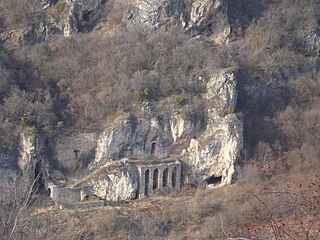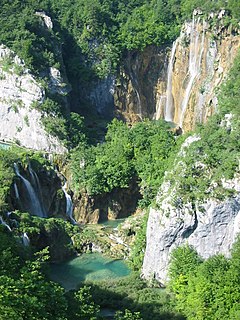Public holidays in Croatia are regulated by the Holidays, Memorial Days and Non-Working Days Act.
Unique Master Citizen Number is a unique identification number that was assigned to every citizen of former Yugoslav republics of the SFR Yugoslavia. Today it continues to be used in almost all of the countries that were created after the dissolution of Yugoslavia – Bosnia and Herzegovina, Montenegro, North Macedonia, Serbia and Slovenia use it in its original form, while Croatia has switched to a new identification number called the Personal Identification Number.
Croatia recognizes life partnerships for same-sex couples through the Life Partnership Act, making same-sex couples equal to married couples in everything except adoption. However, the Act does provide couples with an institution similar to stepchild adoption called partner-guardianship. The Act also recognizes and defines unregistered same-sex relationships as informal life partners, thus making them equal to registered life partnerships after they have been cohabiting for a minimum of 3 years. Croatia first recognized same-sex couples in 2003 through a law on unregistered same-sex unions which was replaced by the Life Partnership Act. The Croatian Parliament passed the new law on 15 July 2014, taking effect in two stages. Since the 2013 referendum, the Constitution of Croatia has limited marriage to opposite-sex couples.
Slovenia has recognized partnerships since 24 February 2017. These provide same-sex partners with all the legal rights of marriages, with the exception of joint adoption and in vitro fertilisation. Previously, Slovenia had recognized the more limited registrirana partnerska skupnost for same-sex couples between 2006 and 2017, which gave same-sex partners access to one another's pensions and property.
The State Institute for Nature Protection is an institution centrally responsible for specialized nature protection activities in Croatia.
Franjo Bučar State Award for Sport is the highest recognition that Republic of Croatia gives for extraordinary achievements and contributions of remarkable meaning for the development of sport in Croatia.
So help me God is a phrase often used to give an oath, and most commonly optional as part of an oath of office. It is also used in some jurisdictions as a form of oath for other forms of public duty, such as an appearance in court, service as a juror, etc.

The Diocletian Aqueduct is an ancient Roman aqueduct near Split, Croatia constructed during the Roman Empire to supply water to the Palace of Emperor Diocletian.

The Security and Intelligence Agency is the Croatian security and intelligence service founded in 2006 upon the passing of the Security and Intelligence System of the Republic of Croatia Act and by combining the former Counterintelligence Agency (POA), and the Intelligence Agency (OA) which both ceased to operate.
The Ministry of Maritime Affairs, Transport and Infrastructure of the Republic of Croatia is a ministry in the Government of Croatia.

Hermitage and Monastery of Saint Peter Koriški is a ruin of the hermitage and monastery located in Koriša, Prizren municipality, Kosovo. The monastery and hermitage are on the same location.
The Natural and Cultural Heritage of Croatia comprises sites, monuments, goods and species of particular importance to the Republic of Croatia which are protected by national law. The Croatian constitution states that the protection of natural and cultural heritage, as well as their use needs to be regulated according to the constitution and laws of the Republic of Croatia.
The Register of Cultural Goods of the Republic of Croatia has been established in 1999. The Croatian Ministry of Culture is responsible for the administration of this public register, which has been created according to the Act on the protection and preservation of cultural goods of 1999. The register is a comprehensive list of all cultural monuments under national protection.
The law of Croatia is part of the legal system of Croatia. It belongs to the civil law legal system. It is grounded on the principles laid out in the Constitution of Croatia and safeguarded by the Constitutional Court of the Republic of Croatia.
Kaljaja is an archaeological site, which is located southeast of the village of Balovac, in municipality of Podujevo. Fortification of an irregular trapezoid shape, with the remains of the ramparts was discovered. Remains follow the terrain configuration. Construction technique was cut stone and brick. Lime mortar was used as a bonding material. In some places the wall is preserved up to a height of 4 meters. At the end of the east, south and west walls the towers were located. The east wall was preserved in the length of 120 meters. The preserved remains of the south wall have the length of 15 meters. The west wall has the hape of an arch, 140 meters in length. North wall had a gate with two towers. The site is rated as a cultural heritage since 1 March 1986, and is under protection of Republic of Serbia.
Kaljaja is an archaeological site, which is located in Teneš Do on the hill Kaljaja in Kosovo.
Svrčin was one of the castles of Nemanjić dynasty, built around 1321, on an island in the artificially made Svrčin lake, northeast from present day Uroševac. The exact location of the medieval Svrčin has not been determined precisely because of a lack archaealogical research in the areas in which it is localized, but based on the remains discovered so far, Svrčin was situated between Svrčin hill and present day village Svrčina. It is registered cultural monument under protection of Republic of Serbia from 1967.
Our Lady of Hvosno is a Serbian Orthodox Christian monastery. It is situated at the foot of Mokra Mountain, nearby hamlets Vrelo and Studenica, some 20 kilometers north of Peć, Kosovo. Our Lady of Hvosno was declared Monument of Culture of Exceptional Importance on 10 July 1967, and Republic of Serbia claims to have it under protection.

Čude Canyon is a short but deep canyon created by the Stupčanica river in central-northerneastern part of Bosnia and Herzegovina, in Olovo municipality. The Stupčanica cuts through steep slopes of Gradac, on the right bank, and Krševi, on the left, thus creating over a half of kilometer deep canyon, only 3.8 kilometers long, and just few hundreds meters wide at the rim levels, while at the river level canyon is often only 2-3 meters wide. The "Čude Canyon" is protected natural monument of Bosnia and Herzegovina.







